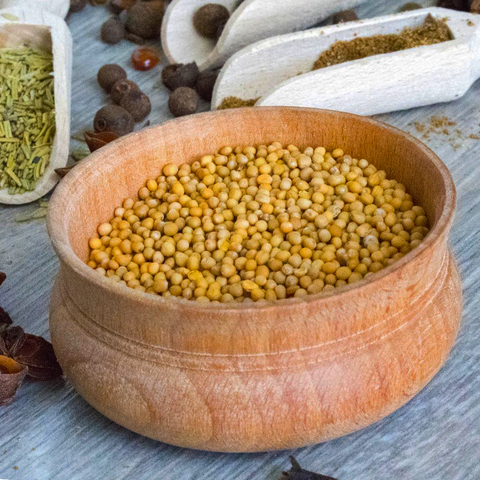Mustard Seeds
What is Mustard?
Mustard seeds are a fiery, floral spice derived from some plants in the family Brassica. The potent flavour and multiple varieties have made it a worldwide favourite as an ingredient or as a condiment.

What does Mustard taste like?
Mustard has a potent flavour with notes of floral bitterness, sweetness all backed by a punchy heat. The spicy flavour of Mustard is felt more in the sinuses and palate than other hot spices like cayenne.
What is Mustard used for?
The seeds can be used whole, ground into a fine powder or hydrated with water or other liquids to activate the hot pungency which mustard is known for. The hydration and preparation methods vary between different country’s traditions. The pH and temperature of the hydrating liquid can significantly alter the flavour profile of the eventual paste.
Having been cultivated and used for so long Mustard has found its way into the recipes of numerous cuisines worldwide. There are a number of different popular preparations of mustard as a condiment: English mustard- bright yellow and very pungent, Dijon- Medium pungency and a paler yellow colour, American mustard- A very mild, bright yellow preparation, Wholegrain mustard- unground mustard seeds mixed with other ingredients.
As a ground powder it is commonly used as a part of various curry powders and occasionally barbecue rubs in American cuisine. The whole seeds are an important pickling spice across the world. The pungent sharp flavours of mustard can bring an exciting sensation and warmth to many recipes.
Mustard Recipes
Here's a few easy recipes to get you inspired:
- Kartoffelmad: Danish style open faced potato salad sandwich
- Homemade mustard
- Indian Potatoes with Black and Yellow Mustard Seeds
Origin and Names
Mustard is one of the most diverse and important cultivated crops on the planet. The genus Brassica contains not only mustard but also: Cabbage, Brussels sprouts, Broccoli, Cauliflower, Kale and Turnips. The genus name Brassica comes from the Latin for cabbage. The common name mustard is thought to come from the Latin words Mustum, referring to the unfermented grape juice used to stabilise the condiment, and Ardens meaning hot or flaming. The three main species of Brassica which are grown for Mustard seeds are Yellow Mustard (B. hirta) , Brown Mustard (B. juncea) and Black Mustard (B. nigra).
Mustard has been cultivated for thousands of years with evidence of its use as far back as 1850 BC in the Indus valley region of the Indian subcontinent.
The two largest producers of mustard seeds are Canada and Nepal, producing over 50% of the annual crop between them. Yellow mustard is widely cultivated and grows wild across much of Europe and central Asia, it is the smallest of the Mustard growing to less than a meter in height . Brown Mustard originated in the foothills of the Himalayas and is now widespread throughout Asia. Black Mustard is less commonly available due to it being harder to process. Both black and brown mustard plants can grow much larger than yellow mustard, reaching up to 3 meters in the right conditions.
